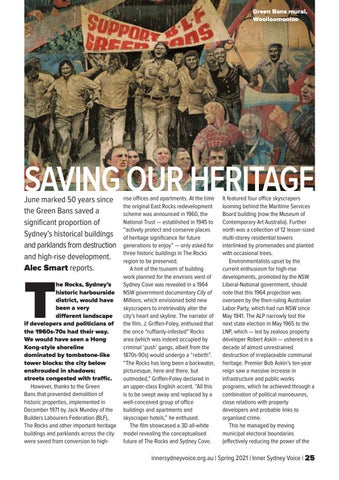Green Bans mural, Woolloomooloo
SAVING OUR HERITAGE
June marked 50 years since the Green Bans saved a significant proportion of Sydney’s historical buildings and parklands from destruction and high-rise development. Alec Smart reports. he Rocks, Sydney’s historic harbourside district, would have been a very different landscape if developers and politicians of the 1960s-70s had their way. We would have seen a Hong Kong-style shoreline dominated by tombstone-like tower blocks: the city below enshrouded in shadows; streets congested with traffic. However, thanks to the Green Bans that prevented demolition of historic properties, implemented in December 1971 by Jack Mundey of the Builders Labourers Federation (BLF), The Rocks and other important heritage buildings and parklands across the city were saved from conversion to high-
T
rise offices and apartments. At the time the original East Rocks redevelopment scheme was announced in 1960, the National Trust — established in 1945 to “actively protect and conserve places of heritage significance for future generations to enjoy” — only asked for three historic buildings in The Rocks region to be preserved. A hint of the tsunami of building work planned for the environs west of Sydney Cove was revealed in a 1964 NSW government documentary City of Millions, which envisioned bold new skyscrapers to irretrievably alter the city’s heart and skyline. The narrator of the film, J. Griffen-Foley, enthused that the once “ruffianly-infested” Rocks area (which was indeed occupied by criminal ‘push’ gangs, albeit from the 1870s-90s) would undergo a “rebirth”. “The Rocks has long been a backwater, picturesque, here and there, but outmoded,” Griffen-Foley declared in an upper-class English accent. “All this is to be swept away and replaced by a well-conceived group of office buildings and apartments and skyscraper hotels,” he enthused. The film showcased a 3D all-white model revealing the conceptualised future of The Rocks and Sydney Cove.
It featured four office skyscrapers looming behind the Maritime Services Board building (now the Museum of Contemporary Art Australia). Further north was a collection of 12 lesser-sized multi-storey residential towers interlinked by promenades and planted with occasional trees. Environmentalists upset by the current enthusiasm for high-rise developments, promoted by the NSW Liberal-National government, should note that this 1964 projection was overseen by the then-ruling Australian Labor Party, which had run NSW since May 1941. The ALP narrowly lost the next state election in May 1965 to the LNP, which — led by zealous property developer Robert Askin — ushered in a decade of almost unrestrained destruction of irreplaceable communal heritage. Premier Bob Askin’s ten-year reign saw a massive increase in infrastructure and public works programs, which he achieved through a combination of political manoeuvres, close relations with property developers and probable links to organised crime. This he managed by moving municipal electoral boundaries (effectively reducing the power of the
innersydneyvoice.org.au | Spring 2021 | Inner Sydney Voice | 25
